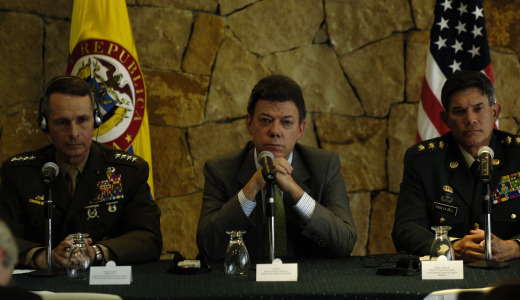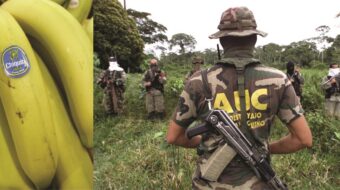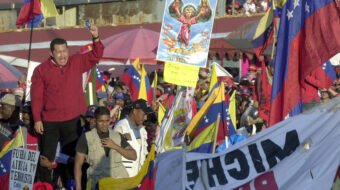
In 1921, socialist writer Scott Nearing wrote that the United States “has guaranteed to her by all the leading capitalist powers practically an exclusive privilege for the exploitation of the Western Hemisphere” as part of the post World War I settling of international affairs.
With military cooperation treaties dating back to 1952, Colombia now serves as a prime tool for U.S. regional control. Analyst Narciso Isa Conde notes that with new U.S. bases, Colombia becomes “a factor of regional aggression,” part of a “fatal triangulation involving Colombia, Honduras, and now Haiti.”
Colombia’s assigned role is to provoke Venezuela, claims a recent Bolivarian News Agency report. “The center of gravity of the strategy is the Bolivarian revolution and the leftist ALBA alliance,” it indicates. Colombia has been “converted into a gigantic air, naval and land forces base to attack Latin America.” Its own military “is being converted into a rapid reaction force.”
Bases along Columbia’s border with Venezuela are being strengthened. Colombian paramilitaries carry out destabilization forays in Venezuela. Colombia is accused of inserting CIA and Israeli trained assassins into Venezuela to target some of those attending the December congress in Caracas of the anti-imperialist Continental Bolivarian Movement. Panama hosts four U.S. bases, and Curacao and Aruba off Venezuela host one each. Fourth Fleet naval power is on call.
For empires power is of the essence. But what of the Colombian people?
Last December horror overwhelmed visiting British unionists and parliamentarians. They learned that leaders of the FENSUAGRO agricultural union confederation are being attacked, jailed, and killed. Families in Soacha told of young men killed by the Army. Dressed as guerrilla combatants, their bodies were displayed as tokens of anti-guerrilla victories. Congresspersons’ telephone calls are monitored. Women political prisoners at the Buen Pastor prison live under “appalling” conditions. The British delegation came under police surveillance.
Community leaders in La Macarena showed them “hundreds of unidentified bodies” in a common grave. The unearthing of 2,000 corpses with British visitors looking on made the news headlines. Azalea Robles’ report is titled: “Largest common grave of the continent is uncovered – Colombia in a paroxysm of horror cries out for solidarity.”
Paramilitary chieftains had revealed gravesite locations to authorities, who took little action. Victims’ families began digging on their own. Under Colombia’s 2002 Law of Justice and Peace, paramilitary capos confessing crimes and demobilizing their commands received short jail terms and could keep properties.
According to jurist Jairo Ramírez, the buried victims represented “social leaders, peasants, and community defenders, not as the Army head told us, guerrillas killed in combat.” Azalea Robles says terror is used “to dissuade [people] from social commitment and to empty extensive territories.” The Army and paramilitaries are engaged in a “dirty war.” Paramilitaries are a “tool of the state,” engineered in part by the CIA. “They subsist on plunder and payments from landowners and multinational corporations.” Sponsoring corporations as determined by the 2008 Permanent Tribunal of the Peoples include CocaCola, Nestle, Chiquita Brands, Monsanto, Dyncorp, BP and Occidental Petroleum among others.
Paramilitary leaders testified to wholesale killings. To inculcate terror, underlings dismembered bodies or threw the dead and dying into crocodile pens and rivers. The Army wanted bodies to vanish so as to exempt the state from legal obligations regarding murder.
Over 25 to 30 years, 50,000 people “disappeared,” the Patriotic Union political party died, and 38 indigenous communities approached extinction. A “scorched earth” policy left 4 million people displaced. During President Alvaro Uribe’s time, 2.4 million Colombians have lost lands and homes, 286,389 during 2009. Multinationals, large landowners, paramilitary bosses and drug traffickers have appropriated 15 million acres. Some 2,700 labor activists have been murdered since 1986, 40 of them last year.
Azalea Robles explains: “Class struggle in Colombia is at its most absolute paroxysm. To preserve the privileges of the oligarchy and above all the plunder of resources perpetrated by multinationals, the Colombian state has implanted total war against the population.”
The Colombian government’s symbiotic relation with the U.S. government exacts a ghastly toll. For Washington, Colombia’s dedication to landowners, urban elites, and multinational corporations bespeaks reliability. Faith in military power pervades both capitals, even though in Colombia it leads to murder, fear, and land stripped of inhabitants.
To enable Colombia to service its imperial ambitions, the U.S. government provides military training, supplies and funding. Part of the bargain is a blind eye toward terrible suffering.
Photo: U.S. Chairman of the Joint Chiefs of Staff Marine Corps Gen. Peter Pace, Colombian Defense Minister Juan Manuel Santos and Chairman of Colombia’s Joint Chiefs of Staff Gen. Freddy Padilla hold a press conference in Bogota, Colombia, Jan. 19, 2007. http://www.defense.gov/dodcmsshare/photoessay/2007-01/hires_070119-F-0193C-015.JPG












Comments